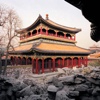In Metropolis Magazine, writer Zha Jianying writes about the reconstruction of a garden in the Forbidden City and the challenges of protecting China’s cultural heritage:
At a May ceremony inside the Forbidden City, Hong Kong real estate tycoon Ronnie Chan”whose China Heritage Fund (CHF) bankrolled the rebuilding of the Jianfugong Garden”profusely thanks the Chinese government officials in attendance. Now that work is complete, Chan says, he is “handing the garden back” to Gugong (the Forbidden City’s Chinese name). Senior functionaries seated in the front row nod graciously. And somehow the moment, rife with order and bureaucracy, reminds me of the 1997 ceremony when Hong Kong was “handed back” to the mainland.
The event, held on a hot, windless Beijing afternoon, feels long and ponderous, so I’m relieved when Calvin Tsao, the New York architect responsible for the project’s interiors, offers to take me on a tour. The rebuilt Jianfugong Garden is a small portion of the Forbidden City, the ancient home of China’s emperors, a sprawling 178-acre complex dating back to 1420 and comprising more than 800 buildings and 8,000 rooms. According to UNESCO, the Forbidden City is the largest collection of preserved wooden structures in the world. [Full text]
– Read more about the reconstructed garden, via People’s Daily.








